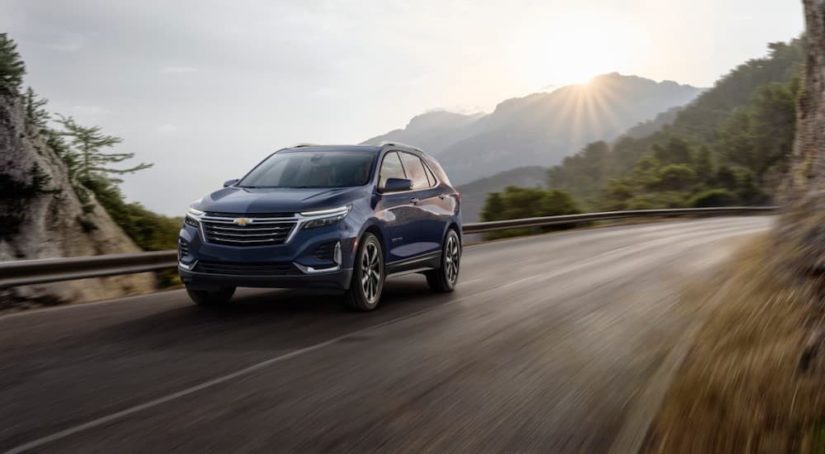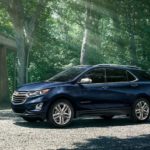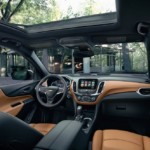The advanced infotainment and safety technologies found on the newest crop of 2022 vehicles tend to capture the most headlines. It makes sense since giant touchscreens and in-vehicle Wi-Fi are exciting features. Sometimes, though, the biggest technological gains happen in the least expected places. Take the 2022 Chevy Equinox and its LED headlights as an example.
People gloss over this upgrade, relegating it to the nice-to-have column, but LED lighting is a critical safety feature and one that many manufacturers are embracing. The topic of exterior vehicle lighting is admittedly not the most exciting conversation starter, but taking the time to understand the difference between Halogen, High Intensity Discharge (HID), and Light-Emitting Diode (LED) technology might change your mind.
As a mid-priced crossover, the Equinox competes in a popular category. Buyers can’t get enough of the crossover body style, whether it’s a value-priced model or a luxury version. The presence of luxury features tends to be the differentiator between these two sub-categories, and believe it or not, the type of headlights found on a vehicle can be one of the most prominent indicators of high-end quality.
Here’s our guide to the three leading headlight technologies and our verdict on which one is superior in both quality and output.
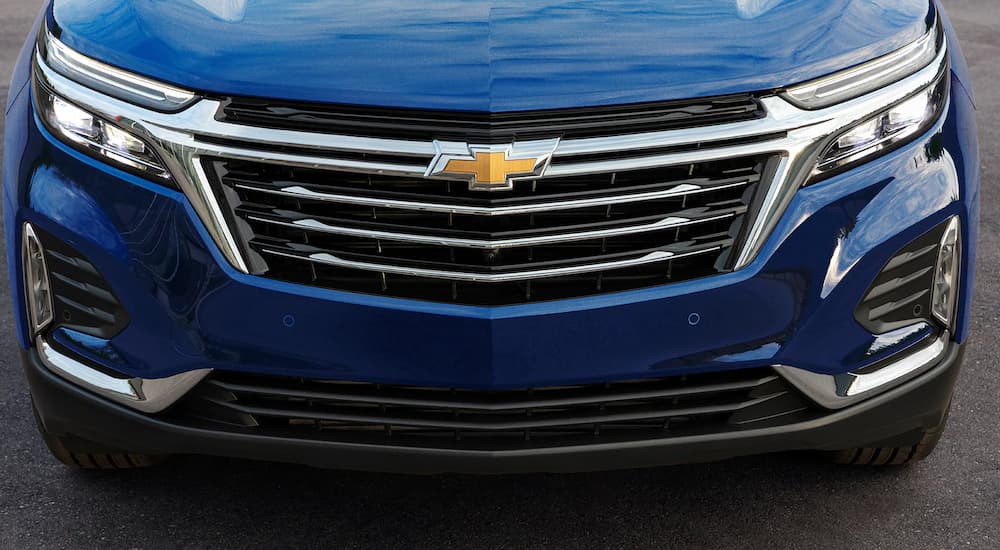
Halogen Headlights – The Basics
Considered the most rudimentary headlight technology, Halogen headlights are inexpensive and still the most common option, particularly on budget-priced models. You can think of Halogen headlights like traditional incandescent light bulbs: they’re not terribly efficient, they use a lot of energy, and they tend to be fragile. Also, Halogen bulbs burn hot and bright, resulting in an overall shorter life (typically under 1,000 hours).
Still, there are plenty of benefits associated with opting for Halogen headlights, the largest of which is price. They’re by far the least expensive option for manufacturers, and owners usually have no trouble finding replacement bulbs at local auto parts retailers. It’s a familiar technology that resonates with buyers who are used to seeing big rectangular headlights on their vehicles. Halogen headlights consume more power than other types of headlights, though, which creates other disadvantages.
Brightness is another measure of the quality of your vehicle’s headlights. Halogen headlights offer an average level of brightness, which essentially means they won’t create a blinding hazard for oncoming traffic. Most of us have experienced the momentary panic that comes from being temporarily blinded by the ultra-sharp brightness of an oncoming car’s lights. As a motorist, it’s nice to know your car isn’t contributing to the problem.
Halogen headlights get their name from the gases used to power them. The headlights contain filaments that heat up and react with the halogen, causing them to illuminate. It’s a whiter light because of the generated heat, which is again why they consume more energy, ultimately asking more from your vehicle’s battery. Anyone that has accidentally left their headlights on in the parking lot only to return to a dead battery can easily understand the amount of power these headlights consume. Even with the drawbacks, though, it’s a 50-year-old technology that has stood the test of time.
HID Headlights – The Basics
HID headlights – also known as Xenon headlights – were introduced in the mid-1990s as a brighter alternative to traditional Halogen lamps. Correlated most closely with the fluorescent lights commonly found in office buildings and other commercial spaces, they rely on Xenon gas for illumination and emit a brighter light than common halogen lights. This is especially beneficial for daytime running lights.
One drawback to HID headlights is they’re not as widely available, so finding aftermarket replacement parts isn’t as easy. Also, they’re more expensive. Originally reserved for high-end luxury cars, HID headlights are now found on mid-priced cars and even some entry-level vehicles, marketed as a premium feature. Indeed, when compared with Halogen headlights, the HID alternative is brighter and more energy-efficient.
The thing is, with all that additional brightness, manufacturers still have to temper output to manage potential issues to other motorists. It’s kind of like having a super fast sports car in the city – sure, there’s plenty of horsepower, but does it matter if you can’t use it? The same holds true for HID technology, and because of that, it’s relegated to mid-range status in the headlight hierarchy.
One other interesting fact about HID headlights: they take a while to warm up. While other types of headlights offer instantaneous illumination, HID headlights gradually illuminate. It doesn’t take long, but drivers will notice a difference, much like they do with certain energy-efficient light bulbs used at home in place of the incandescent variety. It’s small, but noticeable.
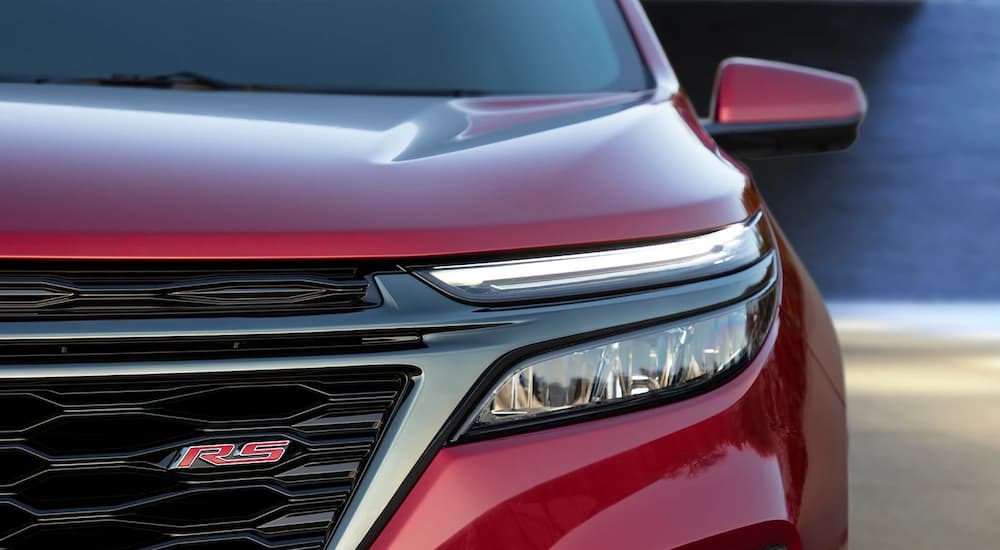
LED Headlights – The Basics
Considered the Cadillac of exterior automotive lighting (although Cadillac didn’t start using them until after Lexus and Audi), LED headlights are by far the most efficient and brightest lights available. What’s especially compelling about LED lights is their configurability. Manufacturers can design unique headlight patterns and still achieve optimal exterior lighting, as evidenced by the newly popular c-shaped and slim slant lighting designs found on a vehicle like the 2022 Equinox.
The added drama is a stylistic boon to automotive designers and consumers alike and aligns well with more modern vehicle styling. Looking at the 2022 Equinox, the eye is immediately drawn to its dramatic grille and integrated lighting. The difference is extra-noticeable alongside vehicles with traditional halogen headlight housings. The horizontal flush-mounted LED headlamps are complemented by the contrasting vertical fog lamps for a look that feels futuristic.
The next wave of LED lighting technology isn’t happening on the vehicle’s exterior: for the latest innovations, you have to step inside the cabin. Nowadays, it’s not uncommon to find color choice ambient LED lighting throughout the cabin. Gone are the days of a single dim light in the headliner. Today you’ll find ambient LED lighting on everything from entry-level cars to luxury sedans. The lights can dim, change color, and some even pulse in time with music.
If you have a spare $250,000, your new Rolls-Royce uses ambient lighting to convert the headliner to a starry night sky. How? Carefully hidden LED light strands installed behind the headliner. Even some less expensive vehicles offer up to 64 different color choices and even themes designed to adapt to your mood and driving style.
Which One is Best?
It’s hard to argue the efficiency and brightness of LED lighting, which is why it’s gaining popularity across every vehicle price and category. Its uses aren’t limited to just headlights, taillights, fog lights, and daytime running lamps – we’re seeing a proliferation of interior ambient lighting features that utilize LED technology for everything from displaying critical safety alerts to infusing the cabin into a coffee shop vibe.
You’ll find the most abundant use of LED technology on the newest crop of electric vehicles. Companies like Chevrolet use LED lighting along with other technology to push the narrative that these vehicles represent the future of the industry. The all-electric Bolt EUV, for instance, features sequential LED turn signals and other features that serve as a preview for what’s to come.
For 2022, Chevy is also making LED lighting standard on many other vehicles in the lineup. The Equinox crossover receives standard LED headlights across the entire trim range, a big change from the previous model year when the feature was only available on the top-of-the-line Premier trim. We expect this isn’t just a trend, but the beginning of a sea change that will soon result in all new vehicles coming standard with LED lighting.
